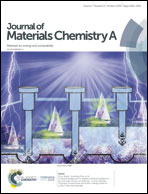Critical roles of potassium in charge-carrier balance and diffusion induced defect passivation for efficient inverted perovskite solar cells†
Abstract
NiO is a well-known hole transporting material (HTM) for hysteresis-free inverted perovskite solar cells (PSCs) due to its wide optical bandgap resulting in low absorption losses, and its high conduction band edge resulting in an efficient electron blocking effect. Nevertheless, the photovoltaic performance of PSCs based on solution-processed NiO is still not pleasing owing to their relatively low short-circuit current density (Jsc) or fill factor (FF), which originates from the relatively low conductivity of NiO and the enormous difference in the mobility of the electron transporting layer (ETL) fullerene and hole transporting layer (HTL) NiO. In this work, K is firstly introduced into NiO to improve its conductivity, carrier extraction capacity and mobility, and thus largely improve its Jsc and FF. Consequently, a best PCE of 18.05% based on K-doped NiO is obtained, resulting in an increment of approximately 15% compared with 15.77% of the device based on pure NiO. The improved conductivity and mobility of NiO by extrinsic dopant K are believed to achieve charge-carrier transport balance from the perovskite to the ETL and HTL, which can effectively avoid charge accumulation within the perovskite or at the interface of the perovskite and HTL. Moreover, the partial diffusion of K induced a moderate excess of PbI2, thus forming type II band alignment between PbI2 and the perovskite, which can passivate the surface or grain boundaries of the perovskite. This work demonstrates that K-doped NiO is a promising HTM for highly efficient inverted PSCs. Meanwhile, this article illustrates a novel defect-passivation mechanism by diffusion.



 Please wait while we load your content...
Please wait while we load your content...